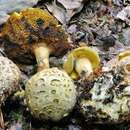en
names in breadcrumbs


Pseudoboletus parasiticus, previously known as Boletus parasiticus and Xerocomus parasiticus, and commonly known as the parasitic bolete, is a rare Boletaceae mushroom found on earthballs (Scleroderma citrinum). Pseudoboletus parasiticus is one of the earliest-diverging lineages of the Boletaceae, after the clade comprising Chalciporus and Buchwaldoboletus.[1]
The cap is hemispherical when young, later flat, yellowish brown or darker and up to 5 cm in diameter. The flesh is pale yellow and the spores are olive. The stem is pale yellow to olive. While edible, it is of poor quality.[2]
 Pseudoboletus parasiticus
Pseudoboletus parasiticus Pseudoboletus parasiticus, previously known as Boletus parasiticus and Xerocomus parasiticus, and commonly known as the parasitic bolete, is a rare Boletaceae mushroom found on earthballs (Scleroderma citrinum). Pseudoboletus parasiticus is one of the earliest-diverging lineages of the Boletaceae, after the clade comprising Chalciporus and Buchwaldoboletus.